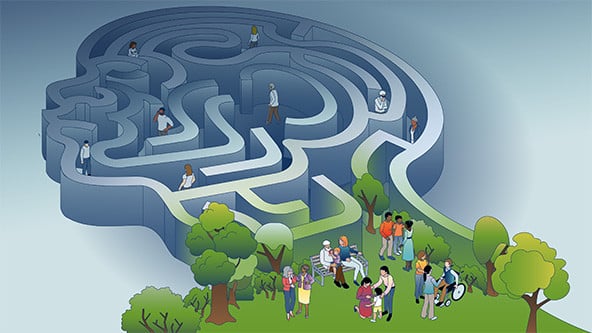Hola, amigos! Today, I’m diving into something that’s been on my mind lately – how we connect with others around us. A fascinating report by Gallup has shed light on how people across the globe feel about their social connections. It’s eye-opening, so let’s unpack it together!

The most recent Meta-Gallup survey, which covered 142 countries, reveals that nearly one in four adults globally, or 24%, report feeling very or fairly lonely. This feeling of loneliness is particularly pronounced among young adults aged 19 to 29, with 27% in this age group experiencing significant loneliness. In contrast, older adults seem to feel less lonely, with only 17% of those aged 65 and above reporting feelings of loneliness.
The Wide World of Connection
First off, it’s incredible to see that a whopping 72% of folks worldwide feel they’re “very” or “fairly” connected to others. That’s about 3.2 billion people feeling the warmth of human connection. But here’s where it gets interesting: this sense of connection isn’t uniform across the board. In some places, like Mongolia, almost everyone’s feeling the love, while in others, the feeling’s not as strong. And, it’s not just about where you live – men and women across the globe report similar levels of connectedness, but the specifics can vary a lot from one country to another.
Loneliness: A Global Challenge
Now, let’s talk loneliness. It’s a mixed bag, with half of the global population not feeling lonely at all – that’s great news! But on the flip side, about 24% of people around the world do feel lonely. This varies a lot by country, with Vietnam on the low end and Lesotho on the high end. Young adults, those vibrant souls between 19 and 29, are feeling lonelier than their older counterparts. This tells us something important about how different stages of life can impact our sense of isolation.
Interacting in Today’s World
Despite our high-tech, always-online world, daily interactions with those around us – like family, neighbours, and even strangers – play a huge role in how connected we feel. Surprisingly, only 16% of people chat with strangers daily. This is something to ponder – how reaching out to a new face might just make our day better.
 So, what does all this mean?
So, what does all this mean?
For starters, it shows us that human connection is a complex and varied tapestry. We’re social creatures by nature, and our interactions, big or small, shape our well-being. Policymakers, take note – understanding these dynamics can help build healthier, happier communities.
Here’s a quick rundown of the key stats:
- Global Social Connectedness: 72% feel connected, representing 3.2 billion people.
- Variation Across Countries: Significant differences in connectedness, with 6% feeling not connected at all.
- Gender and Social Connectedness: Similar levels of connectedness for men (73%) and women (72%).
- Highest and Lowest Rates by Country: Mongolia tops the chart, while the Dominican Republic and the Republic of the Congo are on the lower end.
- Lack of Connection in Certain Countries: Over 10% in countries like Indonesia, Guatemala, and Malawi feel no connection at all.
- Global Loneliness: Half the population doesn’t feel lonely, but 24% do.
- Country-Specific Loneliness: Low in Vietnam, high in Lesotho; higher rates among young adults.
- Daily Interactions with Social Groups: 58% interact daily with friends or family nearby.
- Technology and Distant Connections: A third use tech to connect with distant loved ones.
- Least Interactions with Strangers: Only 16% engage daily with strangers.
- Implications for Policymakers: Insights for health and well-being strategies.
Let’s remember, amigos, every little interaction counts. Whether it’s a friendly chat with the barista or a smile to a stranger, these moments weave the fabric of our social world. So next time you step out, think about how your simple gestures can brighten someone’s day – and yours too!
If you are interested in knowing more read/download the Gallup Report here
Here some of my conclusions and food for thought and some paradoxical ideas that I’d suggest:
Globalization vs. Isolation Paradox: Despite living in an increasingly connected world due to globalization and technology, a notable portion of the global population still experiences feelings of disconnection and loneliness. This paradox suggests that technological connectivity does not necessarily translate into emotional or social connectedness.
Cultural Influences on Social Connectedness: The wide variation in social connectedness and loneliness across countries may reflect cultural differences in social norms, family structures, and community engagement. For instance, countries with a strong emphasis on communal living and extended family structures might report higher levels of connectedness.
Potential for Digital Solutions: The use of technology to maintain long-distance relationships indicates a potential for digital solutions in combating loneliness, especially among those who cannot physically meet with their social circles. This suggests an opportunity for innovative digital platforms that focus more on deepening quality social interactions rather than increasing the quantity of connections.
Age-Related Social Dynamics: The higher levels of loneliness reported among young adults compared to older adults might be reflective of transitional life stages, such as moving for education or work, which can disrupt established social networks. This age group might benefit from targeted social programs or community initiatives.
 Gender Differences in Experiencing Loneliness: The differences in loneliness levels between men and women in some countries might point towards varying societal expectations and roles, which could influence how each gender perceives and reports loneliness.
Gender Differences in Experiencing Loneliness: The differences in loneliness levels between men and women in some countries might point towards varying societal expectations and roles, which could influence how each gender perceives and reports loneliness.
Policy Implications for Mental Health: Given the impact of social connections on mental health, these findings could influence public health policies. Governments might consider investing more in community-building activities and mental health resources, especially in countries with high levels of reported loneliness.
Impact on Workplace Dynamics: For businesses and organizations, understanding the importance of social connectedness could lead to more emphasis on team-building and creating a supportive work environment, which is particularly relevant in diverse workplaces with international teams.
Potential for Cross-Cultural Exchange Programs: The stark differences in social connectedness across countries could open up opportunities for cross-cultural exchange programs aimed at sharing best practices in community building and social engagement.
Role of Urban Planning: The findings might influence urban planning, with a focus on creating spaces that encourage social interaction and community building, especially in densely populated urban areas where anonymity can contribute to loneliness.
Enhancing Global Solidarity: The universal experience of loneliness, despite varying degrees, could be a starting point for international initiatives that promote empathy, understanding, and solidarity across different cultures and societies.
Tags:
#loneliness #connection #depression #connectedness #selfawareness #solidarity
